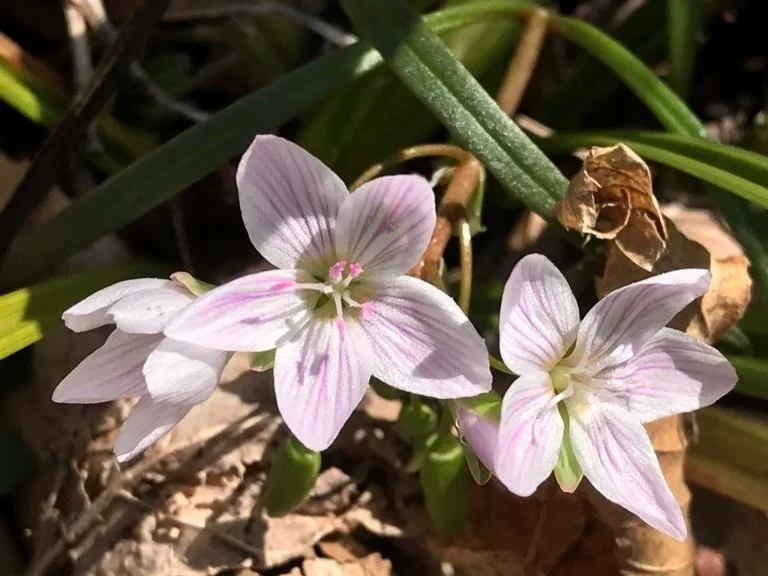April 2025 - On Spring Beauty & the Beauty of Becoming
“I am what I am — not yet.”
Ever since the turning of the season, from winter to spring, I have been circling around ideas of transformation and transition, of beginning and becoming. Spring does that, doesn’t she? With her buds and blossoms, greenery and icy mornings, snow showers followed by “shorts weather,” Spring reminds us that everything is constantly changing, transforming, and becoming. So it’s no wonder my mind is filled with these ideas, too.
One of my favorite educational philosophers, Maxine Greene, once wrote, “I am what I am not yet.” The first time I read this line, I paused, because – “What does that even mean?” I thought, as I read it a second time, and again.
William Pinar, in his writings on Maxine Green’s magnificent collections of essays and speeches, adjusted the punctuation of this phrase to read, “I am what I am–not yet,” which I think helped me see more clearly what Dr. Greene was saying in so few words: that we are who we are right now, and also constantly transforming and transitioning, beginning and becoming.
And if we ever were to stop becoming, well, then, would we even be living?
Maxine Greene’s philosophy of education revolved around the ideas of participation and aesthetic experience, which suggests that she understood that you can’t separate the learning from the learner from the landscape in which it all takes place. Like John Dewey, whose educational theory greatly influenced Dr. Greene, she believed that it is only through interaction with ideas, content, curricula, subject matter, and the people and places around us, that we make sense of our educational experience.
She was known to say that you cannot find meaning; you can only create it. Meaning isn’t waiting for you to uncover it, like a salamander under a log. No, meaning it is made. It is shaped by all that is you and your experience in the world, and by the world itself. This is as true for us as it is for our students, friends, neighbors, and even those with whom we disagree on everything. We are right now, and also we are not yet what we will be in a moment. In a few hours. In a day. In a decade.
Like Spring, we are constantly changing.
What is the saying of April? In like a lion, out like a lamb? An entire month with the theme of becoming something that you are not yet.
As I write this, rain is falling gently outside. I’m glad for this, because I transplanted so many baby plants yesterday - onions, strawberries, lettuce, celery, parsley, cabbage. I seeded radishes, spinach, arugula, and beets. I divided and replanted anise hyssop, black-eyed susan, and golden groundsel. They all need the rain to grow, to thrive, to become what they might one day become - a garden, a meal, a medicine, a home.
As I was planting, the sun was shining, the birds were singing, and I was delighted to find Spring Beauty lifting her face to the sky. Perhaps the sweetest flower of the season, Spring Beauty opens her white petals only when the sun is out, and she bows her head in reverence (or despair?!) on cloudy and rainy days. When her tiny face is lifted, she calls in all the early pollinators with the promise of nectar via pink guidelines running from the tip of her petals to the center of her flower. She goes by many names: Spring Beauty, as we know, Meeautikwaeaugpineeg (Anishnaabemowin), Claytonia virginica (botanical name), and even “fairy spud” in folktales, for the tiny, edible tubers* found below ground.
This particular patch of Spring Beauty came with the house, possibly an intentional planting or, more likely, an ecological remnant from when this place was an oak savannah. Either way, Spring Beauty’s been here much longer than I, though her presence in the garden is always and only temporary. Like all spring ephemeral flowers, she will bloom for a short while, then fade away, her petals, stem, and leaves disappearing from the garden by mid-June. Unlike other herbaceous and woody plants, our ephemerals are just that - ephemeral, short-lived, fleeting, transitory. They flower, share their beauty, feed the earth, then retreat underground, sleeping away the summer, fall, and winter, like a confused black bear. Spring Beauty is for one moment one thing, until the next, when she becomes something else: Bee’s breakfast, Squirrel’s dinner, Gardener’s Delight.
Like you and I, she is – not yet.
As educators and community leaders, we have so much to learn from this season, this plant, and Maxine Greene, like:
Change is inevitable and non-linear.
Meaning isn’t found or given; it is created.
Who we are right now is ephemeral.
There is beauty in blooming, there is beauty in becoming, and there is beauty in transition.
We are always becoming who we are not yet.
So I ask you:
How will you invite the lessons of Spring and Spring Beauty into your life?
How will you show up in your work, like Spring Beauty, to play your unique part, no matter how temporary or short-lived?
How will you allow yourself to become what you are not yet?
What would it look like if we approached teaching and learning with these lessons in mind?
———
May you be happy and healthy.
May you be safe and free.
May you take care of yourself and others
With Grace and Ease.
Sincerely,
Dr. Emily Bretl
*All parts of spring beauty are edible - leaves, flowers, and roots (tuber). However, I recommend eating only the leaves and flowers, and leaving the tubers for next year (and the squirrels and fairies!). When foraging, be sure to correctly identify the plant before consuming any part of it! Bring along a more knowledgeable friend if needed. Also, leave the first, never take the last, and only harvest what you need.
